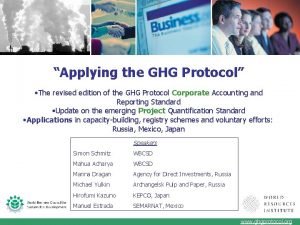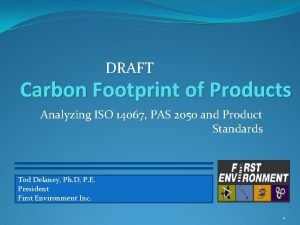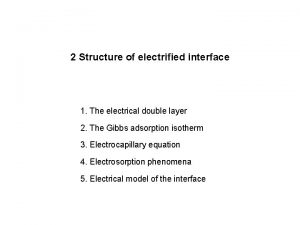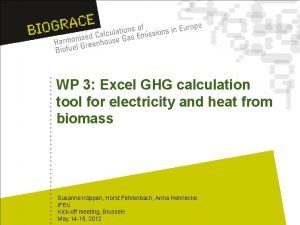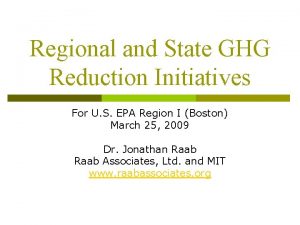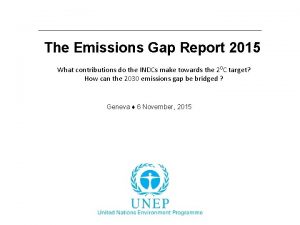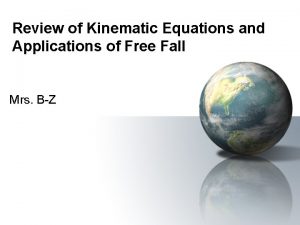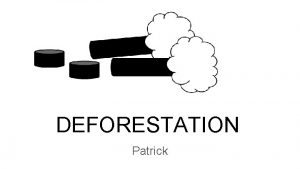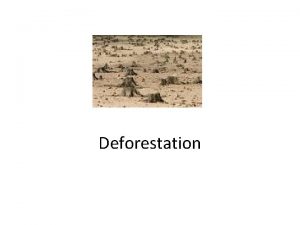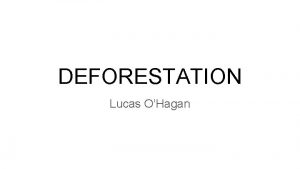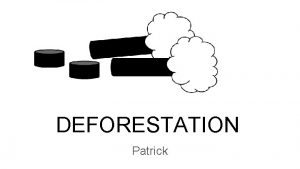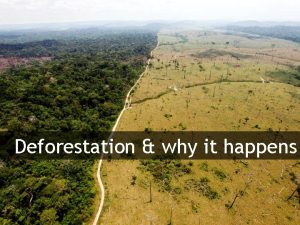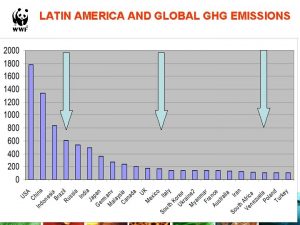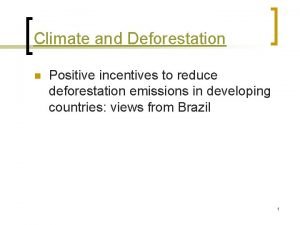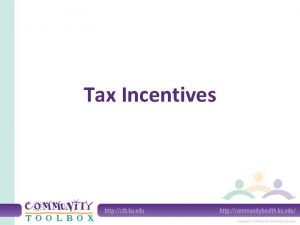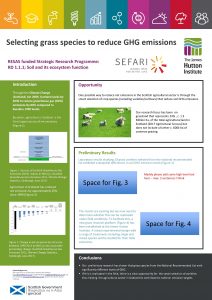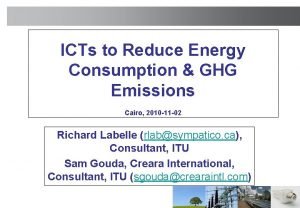Incentives to Reduce GHG Emissions from Deforestation Lessons















- Slides: 15

Incentives to Reduce GHG Emissions from Deforestation: Lessons Learned from Costa Rica and Mexico Katia Karousakis, OECD Bonn May 11, 2007 Annex I Expert Group on the UNFCCC

Background l Reducing emissions from deforestation (RED) in developing countries is important… u u Large emissions from deforestation Can provide incentives to take action Can ensure long-term and sustainable financing Minimise economic costs l Case study approach: lessons learned and good practices from two PES programmes as well as existing climate change framework Annex I Expert Group on the UNFCCC

Outline l Forests and climate change l Case studies: Costa Rica and Mexico l Towards a carbon instrument for RED Annex I Expert Group on the UNFCCC

Forests and Climate Change l Global deforestation ~ 13 million ha/yr l Major source of LULUCF emissions l Main source of GHGs from many developing countries l Higher than total amount produced by transport sector annually (globally) Annex I Expert Group on the UNFCCC

Case studies: Payments for Environmental Services Deforestation and use for pasture Benefits to land users Conservation (with payment for service) Payment Costs to downstream population Source: Pagiola and Platais, 2005 Annex I Expert Group on the UNFCCC

Case Studies: Methodology l Context of Forest Trends l Legal Framework l Institutional Framework l Financing l Baseline, Additionality, Leakage l Monitoring, Reporting and Evaluation l Compliance, Penalties and Enforcement Annex I Expert Group on the UNFCCC

Costa Rican and Mexican PES Costa Rica Mexico Reduce deforestation; improve water quality Hydrological services, scenic beauty, biodiversity, carbon sequestration Hydrological services Private landowners, indigenous reserves Private landowners, ejidos, communidades 1 -300 ha (600 for indigenous reserves) 200 ha (20 -30, 000 for ejidos & communidades) Status quo Broad criteria Use criteria, evolving N/A No measures IPMS -- Equipment GIS Satellite imagery (Ikonos, IRS, Quickbird) Penalties for non -compliance No Yes (non-payment) Policy Goals Covered services Eligibility Size restrictions Baseline Additionality Leakage Contracts Annex I Expert Group on the UNFCCC

Towards a Carbon Instrument for RED l Several market-based options are available for a RED instrument u Sectoral crediting mechanism n Cap and trade n Baseline and credit u Project based mechanism l Actual design would depend on post 2012 climate change framework Annex I Expert Group on the UNFCCC

RED Legal and Institutional Framework l International level: u Monitoring and reporting u Minimum eligibility requirements u Conflicting policy incentives? l National level: u Property rights u Authorise implementing agency u Conflicting policy incentives? n Could set up national oversight body – e. g. , Costa Rica, JI) Annex I Expert Group on the UNFCCC

RED Financing l Design issues to be addressed: u Who receives payments? u What is the payment mechanism? u When are payments made? u What are payments made for? Annex I Expert Group on the UNFCCC

RED Baselines, Additionality, Leakage l Could have emissions cap (sectoral) or baseline (sectoral or project) l Cap requires base year or ‘period’ l Baseline requires reliable emissions data and projections at the forestrysector level l Pros and cons re: leakage, transaction costs, perverse incentives Annex I Expert Group on the UNFCCC

Features of Market-based Approaches to RED Sectoral cap and trade Sectoral baseline and credit Project based mechanism Single base year or period of emissions Single sectoral baseline Multiple project baselines Minimised Yes International leakage Yes Yes Admin and transaction cost Low High Perverse incentives Possibly Yes Limit total emissions High Medium to high Low to medium Government/Land users Data requirements Domestic leakage Payment recipient Annex I Expert Group on the UNFCCC

RED Monitoring and Evaluation l Monitoring framework 1. 2. 3. Core technical functions Management process Institutional context 1 2 3 l Monitoring requires: u u Changes in forest and vegetation cover Changes in carbon stocks Changes in other GHG producing activities Estimate emissions Annex I Expert Group on the UNFCCC

RED Compliance, Penalties and Enforcement l Penalty would depend on design of instrument n cap-&-trade vs. baseline-&-credit n binding vs. non-binding targets u Penalty above and beyond non-payment for avoided emissions? u Insurance mechanisms in case of accidental non-compliance? Annex I Expert Group on the UNFCCC

Conclusions l Potential exists to reduce large fraction of GHG emissions at low cost, with cobenefits l Accurate and consistent monitoring and reporting mechanisms are essential l Capacity building efforts are required l Further analytical research needed to develop and share ideas on design issues Annex I Expert Group on the UNFCCC
 Using citys heat reduce emissions
Using citys heat reduce emissions Ghg protocol revised
Ghg protocol revised Iso 14067
Iso 14067 Structure of electrified interface
Structure of electrified interface Ghg protocol ict sector guidance
Ghg protocol ict sector guidance Ghg protocol ict sector guidance
Ghg protocol ict sector guidance Biograce
Biograce U.ghg
U.ghg Ghg exercise
Ghg exercise Un emissions gap report
Un emissions gap report Splonc
Splonc Sources of nox emissions
Sources of nox emissions Flame test results table
Flame test results table 4 kinematic equations
4 kinematic equations Volkswagen ethical dilemma
Volkswagen ethical dilemma Parts of sperm cell
Parts of sperm cell

